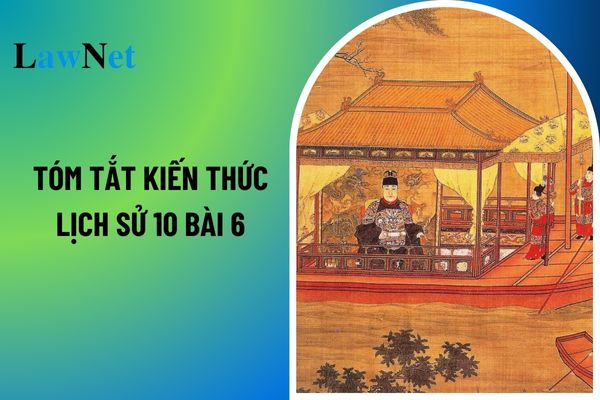Vietnam: What is the summary of 10th-grade history knowledge in Lesson 6: Ancient - Medieval Civilization? What is the content of knowledge on history and life for 10th-grade History?
What is the summary of 10th-grade history knowledge in Lesson 6: Ancient - Medieval Civilization?
Below is a sample summary of 10th-grade history knowledge in Lesson 6: Ancient - Medieval Civilization:
I. Ancient Greek – Roman Civilization
1. Foundational Basis:
- Natural conditions: Located on the Southern European peninsula, the land is arid but rich with natural resources (copper, iron, etc.).
- Population and society: Comprised of two main classes, the slave owners and slaves, along with other classes such as peasants and merchants.
- Economy: Developed handicrafts, commerce, and estate-based agriculture (in Rome).
- Politics:
+ Greece had city-state republics (8th - 4th century BC).
+ Rome transitioned from a republic (1st century BC) to an empire (year 27 BC).
+ Learned from Eastern civilizations: Adopted techniques, writing, and architectural art.
2. Basic Achievements:
- Writing:
+ Greece created a 24-letter alphabet.
+ Rome developed Latin script – widely used today.
+ Literature: Primarily based on mythology, prominent in poetry, prose, and drama.
+ Architecture, sculpture: Works like the Parthenon temple, the statue of Venus.
- Science, technology:
+ Astronomy: Acknowledged Earth's spherical shape.
+ Mathematics, physics: Famous scientists like Pythagoras, and Archimedes.
+ Medicine: Research on anatomy, and anesthesia.
+ History: Herodotus (Greece), Polybius (Rome).
+ Thought: The birthplace of Western philosophy, with the struggle between materialism and idealism.
+ Sports: Organizing events such as the Olympics, laying the foundation for modern sports.
II. Western European Civilization during the Renaissance
1. Historical Background:
- Economy: Formation of capitalist production relations but faced obstacles.
- Culture: Restored Greco-Roman values, creating a new culture for the bourgeoisie.
- Society: Intense conflicts between the people and the feudal class, the church.
2. Basic Achievements:
- Literature: Success in genres like poetry, novels, and drama.
- Painting, architecture, sculpture:
- Emergence of many famous painters like Leonardo da Vinci, and Michelangelo.
- Architecture focusing on proportion and symmetry.
- Science and technology: Inventions in textiles, mining, shipbuilding, weapons.
- Thought:
+ Emphasizing human values, individual freedom, and national spirit.
+ Opposing the church and feudal policies.
3. Role:
- The Renaissance paved the way for the robust development of Western European civilization in the early modern and modern periods, contributing to promoting values of freedom and creativity.
Note: The above summary of 10th-grade history knowledge on Lesson 6: Ancient - Medieval Civilization is for reference only!

What is the summary of 10th-grade history knowledge in Lesson 6: Ancient - Medieval Civilization? What is the content of knowledge on history and life for 10th-grade History in Vietnam? (Image from the Internet)
What is the content of knowledge on history and life for 10th-grade History in Vietnam?
Under the General Education Program in History issued with Circular 32/2018/TT-BGDDT, the content of knowledge on history and life for 10th-grade history is specified as follows:
Role and significance of historical knowledge
- The need to understand human origins and cultural identity throughout all eras
- Drawing and applying experiences in real-life
- Forecasting the future
Lifelong learning and discovery of history
- The necessity of lifelong learning and discovering history
- Gathering information, historical materials, enriching historical knowledge
- Connecting knowledge, and historical lessons to life
What learning outcomes are required for the Chapter of History and Historiography in the 10th-grade History curriculum in Vietnam?
Under the General Education Program in History issued with Circular 32/2018/TT-BGDDT, learning outcomes required for the Chapter of History and Historiography in the 10th-grade History curriculum in Vietnam are as follows:
- Present the concept of history.
- Distinguish between actual history and perceived history through specific examples.
- Explain the concept of historiography.
- Present the object of study of historiography through specific examples.
- State the functions and duties of historiography through specific examples.
- State the significance of some basic principles of historiography: objectivity, truthfulness, progression.
- Differentiate historical sources: written, historical artifacts, etc.
- State some basic methods of historiography: historical method, logical method, presenting history chronologically and synchronically, interdisciplinary approach method. Begin to apply some basic methods of historiography through specific exercises (at a simple level).
- State the role and significance of historical knowledge to the life of modern individuals and society through specific examples.
- Explain the necessity of lifelong learning of history.
- Know how to collect, gather, and process information, and historical materials to learn and discover history.
- Apply historical knowledge and lessons to explain current issues in the country and the world, issues in real life (at a simple level).
- Show interest, and fondness, and participate in activities exploring the history and culture of Vietnam and the world.

